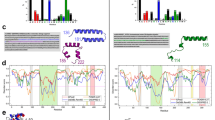Abstract
Tardigrades are one of the most stress-resistant complex organisms on the Earth, of particular interest is their high radioresistance. The protein Dsup (Damage suppressor) recently discovered in R. varieornatus is directly related to a decrease of the level of nuclear DNA damage by ionizing radiation; however, the mechanism of this process is not fully understood. To better understand the function and origin of the Dsup protein, a comparative analysis of the amino acid sequence of this protein with the amino acid sequences of proteins in open databases was carried out. We showed that other DNA-binding proteins of tardigrades have the highest similarity for the Dsup protein, including histone proteins and proteins involved in the response to stress, as well as the SRP40 yeast protein. Thus we hypothesize that Dsup could arise from some ancestral histone-like protein.
Similar content being viewed by others
REFERENCES
N. Møbjerg and R. C. Neves, “New insights into survival strategies of tardigrades,” Comp. Biochem. Physiol., Part A 254, 110890 (2021).
C. Hesgrove and T. C. Boothby, “The biology of tardigrade disordered proteins in extreme stress tolerance,” Cell Commun. Signal 18, 1–15 (2020). https://doi.org/10.1186/s12964-020-00670-2
T. Hashimoto, D. D. Horikawa, Y. Saito, H. Kuwahara, H. Kozuka-Hata, T.-I. Shin, Y. Minakuchi, K. Ohishi, A. Motoyama, T. Aizu, et al., “Extremotolerant tardigrade genome and improved radiotolerance of human cultured cells by tardigrade-unique protein,” Nat. Commun. 7, 12808 (2016).
D. D. Horikawa, T. Kunieda, W. Abe, M. Watanabe, Y. Nakahara, F. Yukuhiro, T. Sakashita, N. Hamada, S. Wada, T. Funayama, et al., “Establishment of a rearing system of the extremotolerant tardigrade Ramazzottius varieornatus: A new model animal for astrobiology,” Astrobiology 8, 549–556 (2008).
M. Mínguez-Toral, B. Cuevas-Zuviría, M. Garrido-Arandia, and L. F. Pacios, “A computational structural study on the DNA-protecting role of the tardigrade-unique Dsup protein,” Sci. Rep. 10, 1–18 (2020).
S. Tanaka, J. Tanaka, Y. Miwa, D. D. Horikawa, T. Katayama, K. Arakawa, A. Toyoda, T. Kubo, and T. Kunieda, “Novel mitochondria-targeted heat-soluble proteins identified in the anhydrobiotic tardigrade improve osmotic tolerance of human cells,” PLoS One (2015). https://doi.org/10.1371/journal.pone.011827
U. T. Meier, “Comparison of the rat nucleolar protein Nopp140 with its yeast homolog SRP40. Differential phosphorylation in vertebrates and yeast,” J. Biol. Chem. 271, 19376–19384 (1996).
C. Chavez, G. Cruz-Becerra, J. Fei, G. A. Kassavetis, and J. T. Kadonaga, “The tardigrade damage suppressor protein binds to nucleosomes and protects DNA from hydroxyl radicals,” Elife 8, 1–20 (2019).
M. Zarubin, A. Gangapshev, Y. Gavriljuk, V. Kazalov, and E. Kravchenko, “First transcriptome profiling of D. melanogaster after development in a deep underground low radiation background laboratory,” PLoS One (2021). https://doi.org/10.1371/journal.pone.0255066
M. Zarubin, A. Yakhnenko, and E. Kravchenko, “Transcriptome analysis of Drosophila melanogaster laboratory strains of different geographical origin after long-term laboratory maintenance,” Ecol. Evol. 10, 7082–7093 (2020).
Author information
Authors and Affiliations
Corresponding author
Ethics declarations
The authors declare that they have no conflicts of interest.
Rights and permissions
About this article
Cite this article
Zarubin, M., Kuldoshina, O. & Kravchenko, E. Unique Radioprotective Damage Suppressor Protein (Dsup): Comparative Sequence Analysis. Phys. Part. Nuclei Lett. 19, 309–311 (2022). https://doi.org/10.1134/S1547477122030207
Received:
Revised:
Accepted:
Published:
Issue Date:
DOI: https://doi.org/10.1134/S1547477122030207




